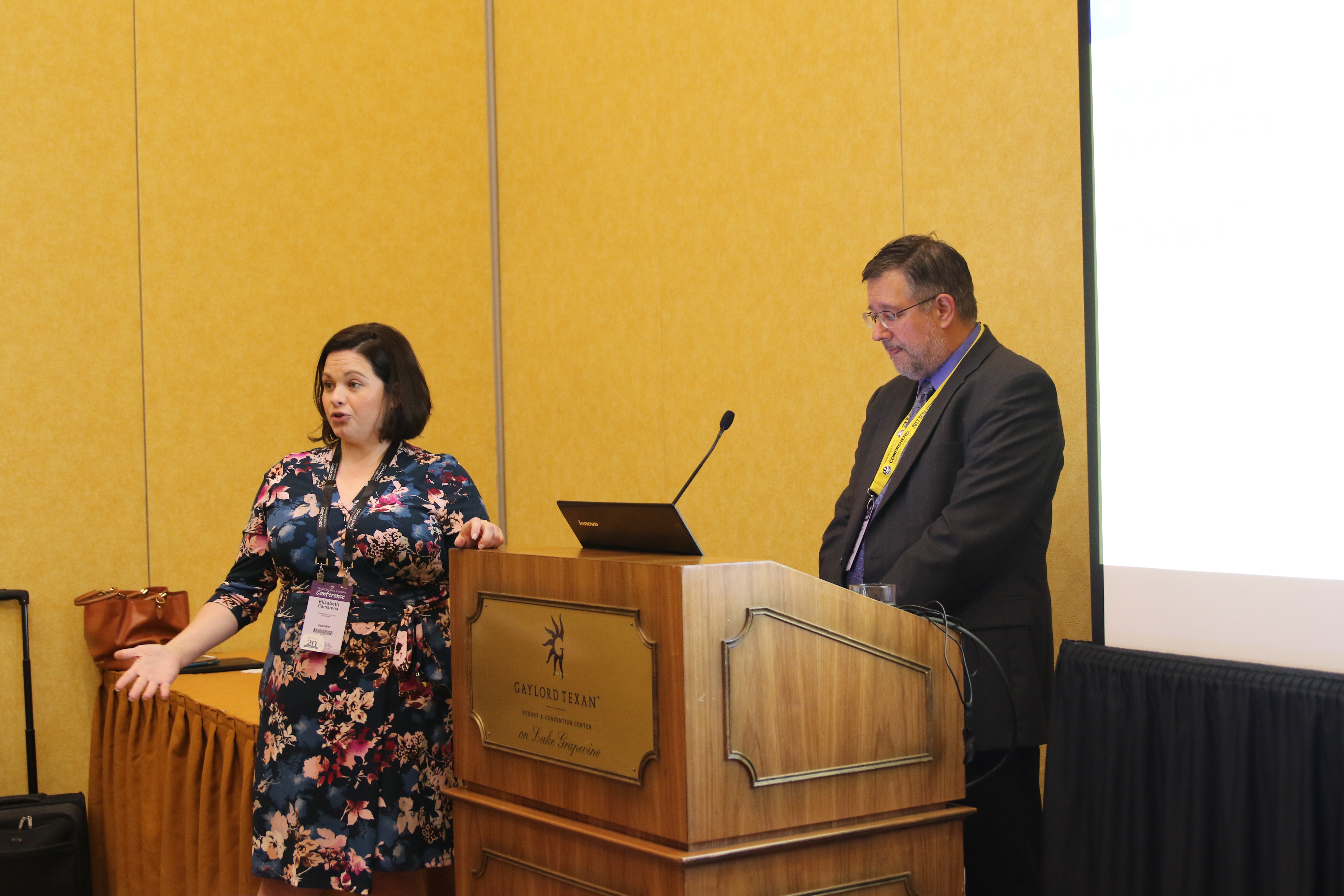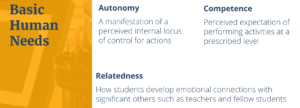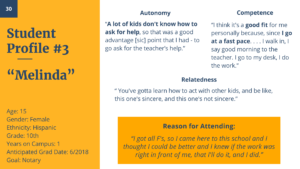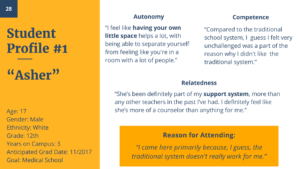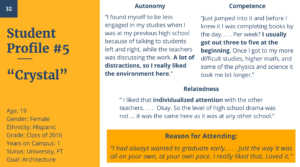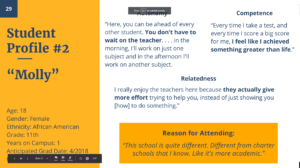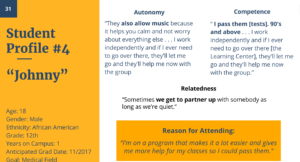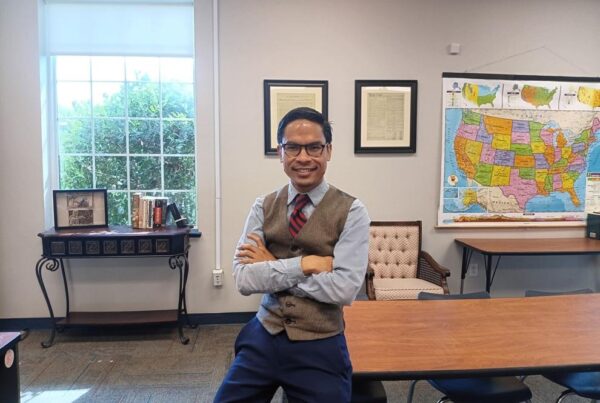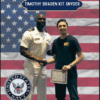In Texas alone, 33,466 students in grades seventh-12 dropped out of public schools during the 2015-16 school year. Students come from diverse backgrounds and each has different needs, which can make it difficult to graduate from a traditional public school program. Recognizing that many students need a different kind of program that offers them a personalized experience, charter school operator ResponsiveEd launched Premier High School’s personalized and blended learning program in 1999.
This past year ResponsiveEd’s Executive Director of Research, Evaluation, and Instruction Steven Bourgeois, and Director of Learning Systems Elizabeth Camarena worked on a case study to better understand the dropout recovery population’s needs and the best ways to help them meet their potential.
At the 2017 Texas Charter Schools Conference, Dr. Bourgeois and Ms. Camarena provided attendees with an understanding of the educational model that offers hope for dropouts  through their research on moving students from dropout recovery to college readiness. Their goal was to:
through their research on moving students from dropout recovery to college readiness. Their goal was to:
- Better understanding of students’ reasons for enrolling in dropout recovery programs
- Discover how students gain academic confidence through mastery-learning systems
- Understand the perspectives of the students, parents, teachers, and administrators
Interviewing students, parents, teachers, and administrators, Dr. Bourgeois and Ms. Camarena concluded that; 1) students in dropout recovery schools have complex backgrounds and require a flexible academic program, 2) a minimum-skills academic program fails to meet the needs of a substantial proportion of students within this context, and 3) schools focus must be to foster quality student motivation and to help our all of our students meet their potential.
In their presentation, they focused on the insights of participating teachers, parents, and students. A sampling is presented below:
Teachers’ Insights
Teachers identified two types of students who benefit from a precision mastery learning system. One student type has fallen behind and is thinking of dropping out. The reasons for falling behind can range from not fitting in, to needing to support a family. The other type of  student wants to get ahead. These students are often introverts who want to get their schoolwork done and move on.
student wants to get ahead. These students are often introverts who want to get their schoolwork done and move on.
They identified three important steps that need to take place for student success:
Facilitate a transition to self-regulated learning: “Some students come in and they’re good students but the public school is not working for them. They come in and I think it’s a pretty quick adjustment for some of these students where they figure out the model, they figure out the program.”
Cultivate students’ momentum for learning: “I have observed that the ones that stick with it, that stay in the school, stay in the program, eventually I’ve noticed that as they go from freshmen if they come in early as a freshman and sophomore, they start picking up the pace. They gradually figure it out and they start getting motivated. They’re seeing the light at the end of the tunnel. By the time they’re a senior, they’re pushing pretty quickly through it.”
Empower Independent Learners: “We need to grab the student right away, the student needs to be identified right away, and then we need to be able to wrap them into our environment. . . . The program is set such that when they come in, we’re just easing them into the program and gently prodding them and helping them along. The program itself encourages independent learning.”
Parents Insights
Parents identified five differences in the Premier High School program that had a positive effect on their children:
“So, he did like a180 degree turn on his … and from there he’s been able to focus. It’s a smaller place. The teachers pretty much know everybody. And, I’ve always been upfront with the teachers in letting them know, you know, that how he used to be and just keep an eye out and let me know, call me. And, you know, how do I say this, he monitors himself now. You know, he’s more in control of what he’s doing and he’s noticing the other kids that are being annoying and loud.”
- Self-monitoring and taking on responsibility for their work
- Approachable campus leader
- Shifting toward a college-ready mindset
- Safe learning environment
- Providing support to empower students to learn at their own pace
Students’ Insights
- TCSA Ex
- TCSA Melinda
- TCSA Asher
- TCSA Crystal
- TCSA Molly
- TCSAJohnny
In the present study, the frame of self-determination theory (Deci & Ryan, 1985; Ryan & Deci, 2017) informs the research design, research questions, interview questions, and data analysis. Furthermore, the researchers tested the extent to which self-determination theory informs our understanding of the data from the context of a credit recovery program. Self-determination theory is a meta-theory of motivation that posits three basic human needs, including autonomy, competence, and relatedness (Deci & Ryan, 1985). Autonomy represents a perceived internal locus of control for actions (Deci & Ryan, 1985); competence represents the expectation of successful performance of tasks; and relatedness concerns how students interact with significant others (Deci, Vallerand, Pelletier, & Ryan, 1991). According to Deci et al. (1991) self-determined acts are “fully endorsed” (p. 328) and intrinsically motivated at the cognitive level. The degree to which these needs are met either fosters or thwarts individuals’ intrinsic motivation to learn about and act upon their environment (Deci & Ryan, 1985). This theory is particularly appropriate for the credit recovery context because programs of this nature encourage students to take ownership of their learning, representing autonomous regulation. Recognizing that students may come to credit in a fragile state, typically due to a lack of success in the traditional school environment, credit recovery programs seek to provide success early and often, enhancing self-efficacy beliefs and feelings of competence. Finally, credit recovery programs typically involve a relatively small learning environment, allowing for close and supportive relationships with teachers and fellow students–a crucial element to foster a sense of relatedness.
Final Thoughts
The results of the study indicate three key needs of dropout recovery schools. First, because the students have complex backgrounds, they need a flexible academic program. Second, a program focused only on minimum-skill academics does not meet the needs of a substantial portion of these students. Finally, a school’s focus must be on fostering quality student motivation and helping all of its students meet their potential.
In addition to presenting Moving Students from Dropout Recovery to College Readiness: A Case Study, Dr. Bourgeois, and Elizabeth Camarena joined with Premier High School Campus Director Jennifer Kasapi to explore the elements of the targeted mastery learning system implemented at ResponsiveEd’s Premier High Schools and iSchool High campuses. Their presentation was titled Personalized and Blended Learning: Learning Belongs to the Learner.
Later that week, with the support of Elizabeth Camarena, Dr. Bourgeois chaired a panel titled, Approaches to Leveraging Academic Data: A Collaboration Across Charter Organizations. Panel members included representatives from Uplift Education, Life School, and International Leadership of Texas. Dr. Bourgeois shared insights into how ResponsiveEd leverages formative data, including NWEA MAP and local benchmarks, to inform curriculum review, project student outcomes, and target academic interventions.
![]()
